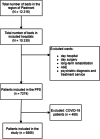Level of implementation of multimodal strategies for infection prevention and control interventions and prevalence of healthcare-associated infections in Northern Italy
- PMID: 38605378
- PMCID: PMC11010422
- DOI: 10.1186/s13756-024-01398-1
Level of implementation of multimodal strategies for infection prevention and control interventions and prevalence of healthcare-associated infections in Northern Italy
Abstract
Background: In November 2022, Italy participated in the third edition of the European Centre for disease prevention and control (ECDC) point prevalence survey (PPS) of healthcare-associated infections (HAIs) in acute-care hospitals. A questionnaire based on the WHO infection prevention and control assessment framework (IPCAF) was included, which aims to investigate multimodal strategies for the implementation of IPC interventions.
Methods: A PPS was conducted using the ECDC PPS protocol version 6.0. The Regional health authority of the region of Piedmont, in north-western Italy, chose to enlist all public acute-care hospitals. Data were collected within one day per each ward, within 3 weeks in each hospital, at hospital, ward and patient level. A score between 0-1 or 0-2 was assigned to each of the 9 items in the IPCAF questionnaire, with 14 points representing the best possible score. HAI prevalence was calculated at the hospital-level as the percentage of patients with at least one HAI over all included patients. Relations between HAI prevalence, IPCAF score, and other hospital-level variables were assessed using Spearman's Rho coefficient.
Results: In total, 42 acute-care hospitals of the region of Piedmont were involved, with a total of 6865 included patients. All participant hospitals reported they employed multimodal strategies to implement IPC interventions. The median IPCAF overall score was 11/14 (interquartile range, IQR: 9.25-12). The multimodal strategy with the highest level of adherence was education and training, followed by communication and reminders. Strategies with the lowest level of adherence were safety climate and culture of change, and system change. Overall HAI prevalence was 8.06%. A weak to moderate inverse relation was found between IPCAF score and HAI prevalence (Spearman's Rho -0.340, p 0.034). No other significant correlation was found.
Conclusions: This study found a high self-reported overall level of implementation of multimodal strategies for IPC in the region. Results of this study suggest the relevance of the multimodal approach and the validity of the IPCAF score in measuring IPC programs, in terms of effectiveness of preventing HAI transmission.
Keywords: Healthcare-associated infections; Infection prevention and control; Italy; Point prevalence survey.
© 2024. The Author(s).
Conflict of interest statement
The authors declare no competing interests.
Figures
References
-
- Bordino V, Vicentini C, D’Ambrosio A, Quattrocolo F, Collaborating Group, Zotti CM Burden of healthcare-associated infections in Italy: incidence, attributable mortality and disability-adjusted life years (DALYs) from a nationwide study, 2016. J Hosp Infect. 2021;113:164–71. doi: 10.1016/j.jhin.2021.04.023. - DOI - PubMed
-
- Cassini A, Plachouras D, Eckmanns T, Abu Sin M, Blank HP, Ducomble T, et al. Burden of six healthcare-associated infections on european population health: estimating incidence-based disability-adjusted life years through a population prevalence-based modelling study. PLoS Med. 2016;13(10):e1002150. doi: 10.1371/journal.pmed.1002150. - DOI - PMC - PubMed
-
- Suetens C, Latour K, Kärki T, Ricchizzi E, Kinross P, Moro ML, et al. Prevalence of healthcare-associated infections, estimated incidence and composite antimicrobial resistance index in acute care hospitals and long-term care facilities: results from two European point prevalence surveys, 2016 to 2017. Euro Surveill. 2018;23(46):1800516. doi: 10.2807/1560-7917.ES.2018.23.46.1800516. - DOI - PMC - PubMed
-
- World Health Organization. Infection prevention and control assessment framework at the facility level. WHO: Geneva; 2018. Available from: https://www.who.int/publications-detail-redirect/WHO-HIS-SDS-2018.9. Cited 2023 Dec 6.
MeSH terms
Grants and funding
- Project no. PE00000007, INF-ACT/Ministero dell'Università e della Ricerca
- Project no. PE00000007, INF-ACT/Ministero dell'Università e della Ricerca
- Sostegno alla Sorveglianza delle infezioni correlate all'assistenza anche a supporto del PNCAR/Ministero della Salute
- Sostegno alla Sorveglianza delle infezioni correlate all'assistenza anche a supporto del PNCAR/Ministero della Salute
LinkOut - more resources
Full Text Sources



